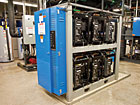
The Second Nature Compact Chiller medium temperature technology is a sustainable refrigeration system designed to reduce refrigerant charge and the potential for leaks. (Photo courtesy of Hill Phoenix)
When Matthews, N.C.-based Harris Teeter Inc. opened a new store in Charlotte, it marked the first installation of Hill Phoenix Second Nature compact chiller units in North America.
The medium-temperature technology is a sustainable refrigeration system using a state-of-the-art approach that reduces system refrigerant by 97 percent over a standard direct expansion (DX) system, and reduces the potential for refrigerant leaks to less than 1 percent throughout the life of the equipment, said Scott Martin, director of sustainability technologies for Hill Phoenix.
Said Michal Shepard, director of energy for Harris Teeter, “We asked Hill Phoenix to look at secondary refrigeration in a new way. Could they find or produce a refrigeration system that would simplify the typical secondary systems? Could they produce these systems as self-contained modules with small charges, no oil systems, and simplified controls that could be stacked together to give us the refrigeration rack-style efficiencies we have today? We also wanted as close to a nonfield serviceable unit as possible.”
Hill Phoenix looked to Europe for guidance. “We were able to find similar technology being utilized in Sweden. We contacted the inventor and worked with him to create our proprietary units,” explained Brad Schwichtenberg, vice president of business development for Hill Phoenix.
SOME CHANGES MADE
The compact chiller takes a bit different approach than the standard Second Nature medium-temperature secondary refrigeration systems. The standard system has air-cooled, parallel compressors and is connected to brazed plate heat exchangers that provide a chilled-water and glycol mixture for cooling display cases and coolers.The compact chiller units have been designed to provide this same cooling effect by paralleling the hydronics side of the secondary system as opposed to the refrigeration side of the system. The units also use a water and glycol mixture as a condensing fluid for compressor heat rejection. This design allows a reduction in refrigerant charge. “The technology is simple: It’s like lining up several home refrigerators to make cold water,” Schwichtenberg noted.
A feature of the design is the multichannel heat exchanger, which is actually three heat exchangers in one. One circuit is for cooling, another circuit is for condensing, and the third is a liquid subcooling circuit that also acts as a buffer between the cooling and condensing sections.
REFRIGERANT MANAGEMENT
Second Nature medium-temperature systems can reduce refrigerant required by 50-75 percent by eliminating refrigerant in long runs to case circuits around the store, Martin said. Cooling at the display cases and coolers is achieved utilizing a 35 percent glycol solution that is delivered via loop piping.Because the medium-temperature secondary refrigerant is not under high pressure like primary refrigerant in a DX system, the Harris Teeter installation uses the Georg Fischer ABS plastic piping system instead of copper pipe. Because the piping that contains HFC refrigerant for the Second Nature compact chiller units is measured in inches, the system is critically charged. The critical charge feature combined with the Hill Phoenix SmartValve™ electronic superheat management system allows a charge of less than eight pounds for a single unit. This further reduces refrigerant requirements and eliminates the need for excess amounts of refrigerant storage within the system that typically accommodates wide swings in ambient conditions, the manufacturer said.
Historically, a typical DX refrigeration installation (total low and medium-temperature) at Harris Teeter required approximately 4,400 pounds of refrigerant. The new installation, which employs medium-temperature Second Nature Compact Chiller units, requires approximately 1,200 pounds, the majority of which is utilized by the low-temperature systems. (The medium-temperature system requires 100 pounds of refrigerant.)
For more information, visit www.hillphoenix.com.
Publication date:09/07/2009

Report Abusive Comment